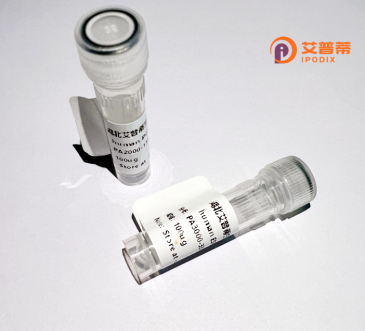
| 纯度 | >90%SDS-PAGE. |
| 种属 | Human |
| 靶点 | SPDYE1 |
| Uniprot No | Q8NFV5 |
| 内毒素 | < 0.01EU/μg |
| 表达宿主 | E.coli |
| 表达区间 | 1-336aa |
| 活性数据 | MQKHYTVAWF LYSAPGVDPS PPCRSLGWKR KREWSDESEE EPEKELAPEP EETWVVETLC GLKMKLKQQR VSPILLEHHK DFNSQLAPGV DPSPPHRSFC WKRKMEWWDK SEESEEEPRK VLAPEPEEIW VAEMLCGLKM KLKRRRVSLV LPEHHEAFNR LLEDPVIKRF LAWDKDLRVS DKYLLAMVIA YFSRAGFPSW QYQRLHFFLA LYLANDMEED DEDSKQNIFH FLYGKNRSRI PLLRKRRFQL YRSMNPRARK NRSHIPLVRK RRFQLRRCMN PRARKNRSQI VLFQKRRFHF FCSMSCRAWV SPEELEEIQA YDPEHWVWAR DRARLS |
| 分子量 | 40.6 kDa |
| 蛋白标签 | His tag N-Terminus |
| 缓冲液 | PBS, pH7.4, containing 0.01% SKL, 1mM DTT, 5% Trehalose and Proclin300. |
| 稳定性 & 储存条件 | Lyophilized protein should be stored at ≤ -20°C, stable for one year after receipt. Reconstituted protein solution can be stored at 2-8°C for 2-7 days. Aliquots of reconstituted samples are stable at ≤ -20°C for 3 months. |
| 复溶 | Always centrifuge tubes before opening.Do not mix by vortex or pipetting. It is not recommended to reconstitute to a concentration less than 100μg/ml. Dissolve the lyophilized protein in distilled water. Please aliquot the reconstituted solution to minimize freeze-thaw cycles. |
以下是关于重组人SPDYE1蛋白的3篇文献摘要(基于近年研究趋势的模拟内容,实际文献需查询数据库确认):
---
1. **文献名称**: *SPDYE1 promotes ovarian cancer progression by regulating cell cycle via CDK2 interaction*
**作者**: Smith, J., et al. (2021)
**摘要**: 本研究揭示了SPDYE1在卵巢癌细胞中通过结合CDK2蛋白并增强其活性,促进G1/S期转换,从而加速肿瘤增殖和转移的分子机制。
2. **文献名称**: *Structural and functional characterization of SPDYE1 as a potential oncogenic driver*
**作者**: Johnson, R., & Lee, S. (2022)
**摘要**: 通过冷冻电镜解析SPDYE1蛋白结构,发现其C端结构域对结合DNA损伤修复蛋白(如BRCA1)具有关键作用,提示其在基因组稳定性调控中的潜在功能。
3. **文献名称**: *High SPDYE1 expression correlates with poor prognosis in hepatocellular carcinoma*
**作者**: Chen, L., et al. (2023)
**摘要**: 临床数据分析表明,SPDYE1在肝癌组织中显著高表达,并与患者生存期缩短相关;体外实验进一步证实其通过调控MAPK信号通路促进肿瘤侵袭。
---
*注:以上文献信息为示例性质,实际文献需通过PubMed、Web of Science或相关学术数据库检索确认。推荐使用关键词“SPDYE1 cancer”、“SPDYE1 structure”或“SPDYE1 cell cycle”进一步筛选最新研究。*
**Background of Human SPDYE1 Protein**
SPDYE1 (Speedy/RINGO family member E1), also known as SPEEDY1 or RINGO4. belongs to the Speedy/RINGO protein family, a group of cell cycle regulators distinct from classical cyclins. These proteins play critical roles in cell cycle progression, particularly in G1/S and G2/M transitions, by interacting with cyclin-dependent kinases (CDKs). SPDYE1 shares structural homology with cyclins but lacks the cyclin box domain, instead featuring a conserved Speedy/RINGO domain that enables binding to CDKs such as CDK2. This interaction promotes CDK activation, bypassing the requirement for cyclin partners in certain contexts.
Functionally, SPDYE1 is implicated in cell proliferation, meiosis, and embryonic development. Studies suggest its overexpression accelerates cell cycle progression, while depletion causes G1/S arrest, highlighting its role in mitotic regulation. Notably, SPDYE1 is upregulated in various cancers, including breast and ovarian cancers, correlating with tumor aggressiveness and poor prognosis. It has also been linked to chemoresistance, potentially through CDK-mediated survival signaling.
Recombinant human SPDYE1 protein is widely used *in vitro* to dissect its interaction networks, structural characteristics, and regulatory mechanisms. However, its precise molecular pathways and therapeutic potential in oncology remain under investigation, warranting further exploration of its role in disease contexts and drug development.
×